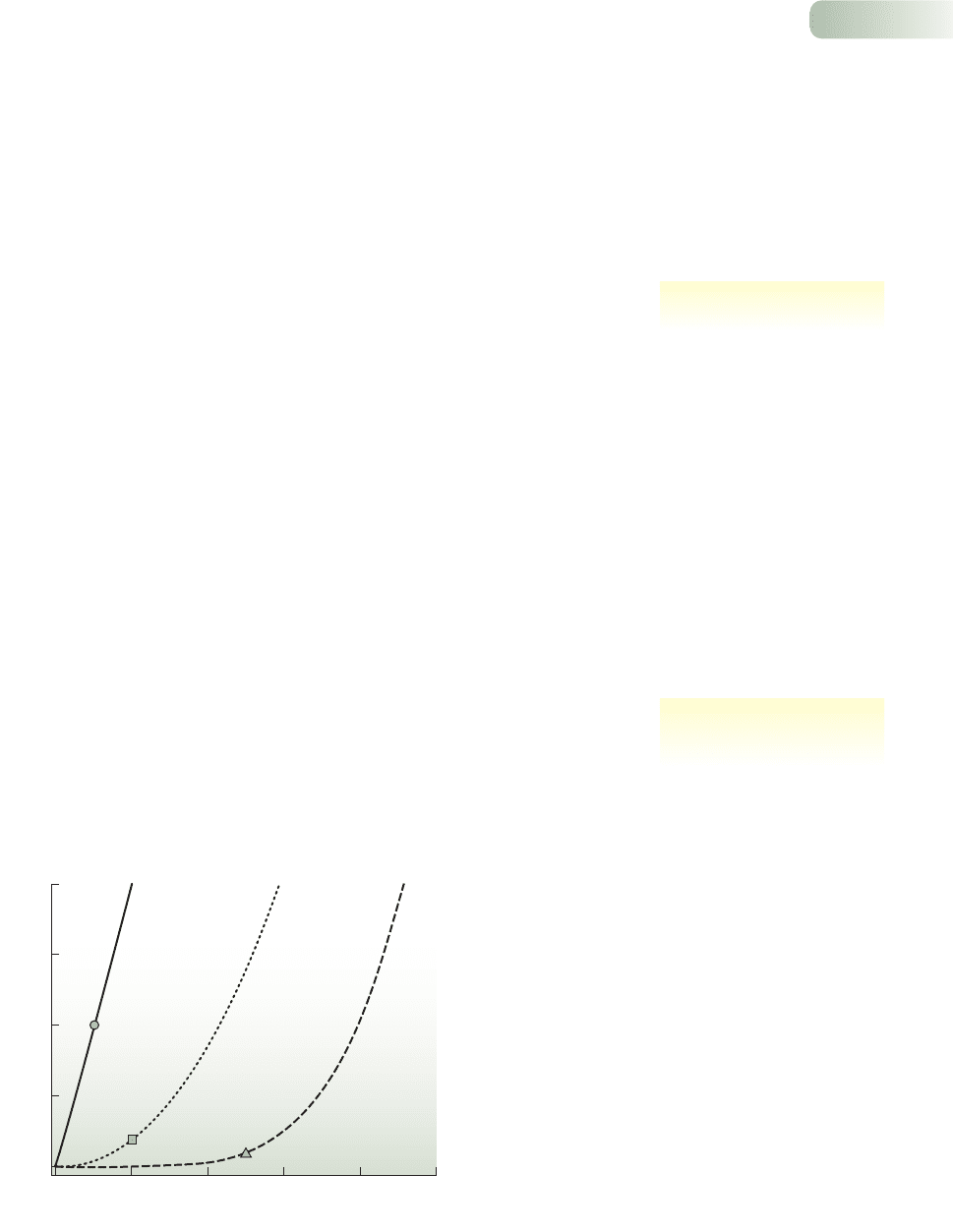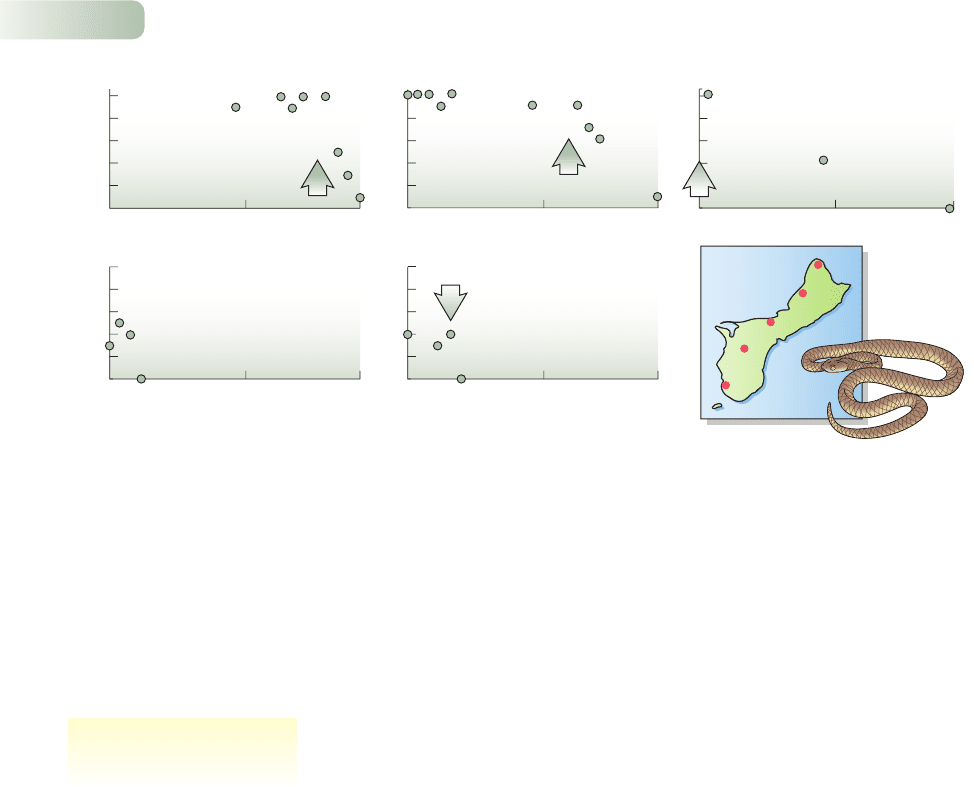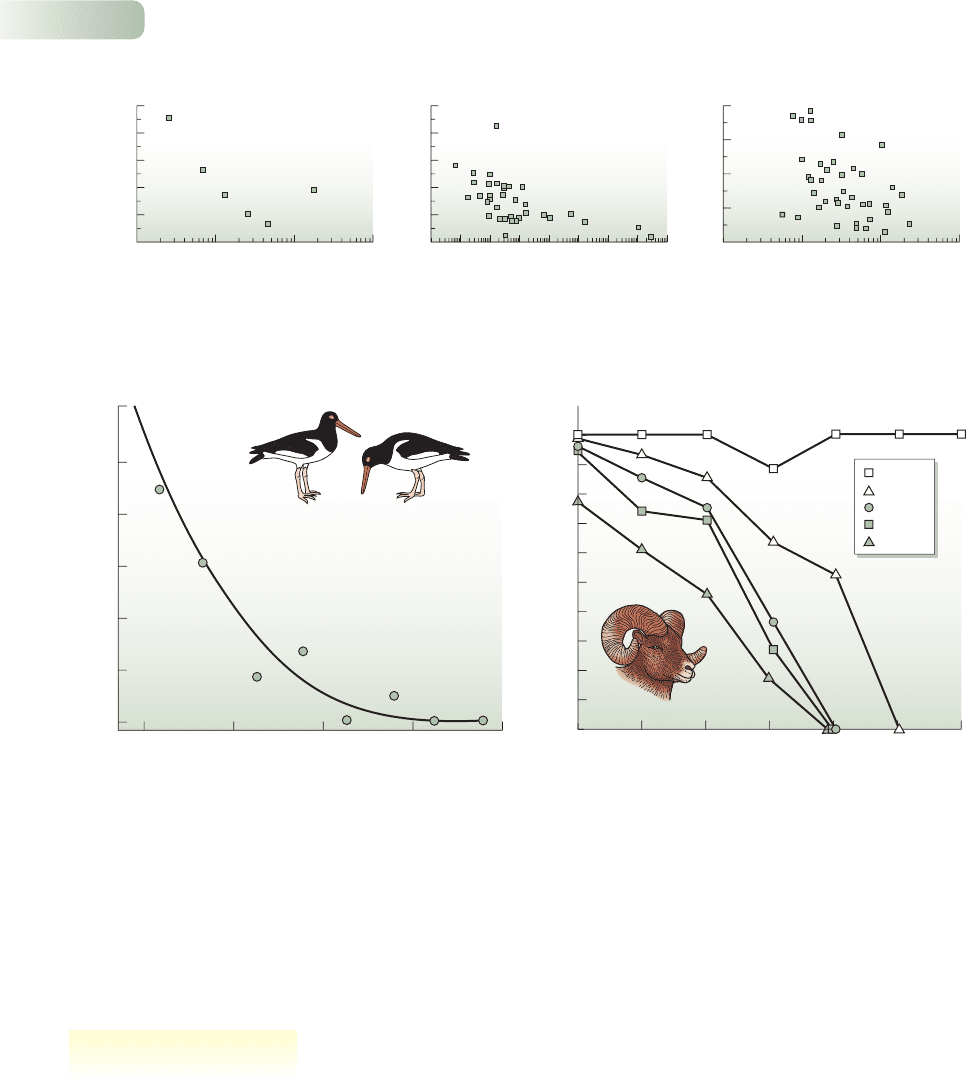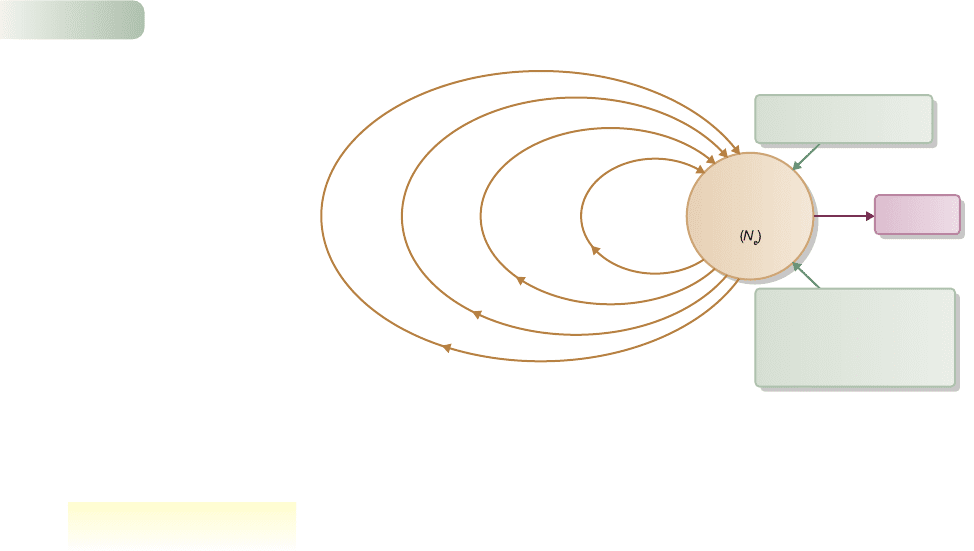Townsend C.R., Begon M., Harper J.L. Essentials of Ecology
Подождите немного. Документ загружается.


Conservation biology relies on an understanding of the threats facing biodiver-
sity (Section 14.2). After presenting this background, we consider in Section 14.3
the options open to conservation biologists to maintain or restore biodiversity.
Then, in Section 14.4 we consider some of the issues confronting conservation
biologists in the face of global climate change. Section 14.5 provides the final
word.
14.2 Threats to biodiversity
A basic aim of conservation is to prevent species from becoming extinct either
regionally or globally. But how do we define the risk of extinction that a species
faces? A species can be described as:
l
critically endangered if there is considered to be more than a 50%
probability of extinction in 10 years or three generations, whichever is
longer (Figure 14.2);
l
endangered if there is more than a 20% chance of extinction in 20 years or
five generations;
l
vulnerable if there is a greater than 10% chance of extinction in 100 years;
l
near threatened if a species is close to qualifying for a threat category or
judged likely to qualify in the near future;
l
of least concern if a species does not meet any of these threat categories
(Rodrigues et al., 2006).
Based on the above criteria, for example, 12% of bird species, 20% of mammals
and 32% of amphibians are threatened with extinction (being critically endan-
gered, endangered or vulnerable; Rodrigues et al., 2006).
Species that are at high risk of extinction are almost always rare, but not all
rare species are at risk. We need to ask what precisely we mean by rare. A species
may be rare in the sense that its geographic range is small, or in the sense that
its habitat range is narrow, or because local populations, even where they do
occur, are small. Species that are rare on all three counts, such as the giant panda
Chapter 14 Conservation
459
200
150
100
50
0
0 0.2 0.4 0.6 0.8 1.0
Probability of extinction
Safe
Endangered
Critical
Time (years)
Vulnerable
Figure 14.2
Levels of threat as a function of time and probability of extinction.
The circle represents a 10% probability (i.e. 0.1) of extinction in
100 years (minimum criterion for a population to be designated
‘vulnerable’). The square represents a 20% probability of
extinction in 20 years (minimum criterion for the designation
‘endangered’). The triangle represents a 50% probability of
extinction in 10 years (minimum criterion for the designation
‘critically endangered’).
AFTER AKÇAKAYA, 1992
the classification of threat
there are several ways of
being rare
9781405156585_4_014.qxd 11/5/07 15:05 Page 459

(Ailuropoda melanoleuca), are intrinsically vulnerable to extinction. However,
species need only be rare in one sense in order to become endangered. For
example, the peregrine falcon (Falco peregrinus) is broadly distributed across
habitats and geographic regions, yet, because it exists always at low densities, local
populations in the USA have become extinct and have had to be re-established
with individuals bred in captivity (see Box 13.1).
Nevertheless, rare species, just by virtue of their rarity, are not necessarily at
risk of extinction. In fact it seems that many, probably most, species are naturally
rare. We have already said (see Chapter 2) that almost everything is almost always
absent from almost everywhere. Succinctly: many species are born rare – but
others have rarity thrust upon them. Other things being equal, it will be easier
to make a rare species extinct, simply because a localized effect may be sufficient
to push it to the brink. Next, therefore, we deal with the various categories of
human influence that increase the chances of species extinction.
14.2.1 Overexploitation
The essence of overexploitation is that populations are harvested at a rate that is
unsustainable, given their natural rates of mortality and capacities for reproduc-
tion (see Section 12.3). We have already discussed the idea that in prehistoric
times humans were responsible for the extinction of many large animals, the
so-called megaherbivores, by overexploiting them (see Section 10.6). In more
recent times, the history of the great whales has followed a similar pattern, while
today we are still taking our toll of other vulnerable giants. Sharks provide an
interesting example. Among the most feared of species (although attacks are much
rarer than held in the popular imagination), large numbers are taken for sport,
many others to make shark fin soup, while a large proportion of the estimated
annual 200 million shark kills are accidental by-catches of commercial fishing.
Evidence is mounting that many species of shark have been declining in abund-
ance, a trend that should come as no surprise given their late ages of maturity,
slow reproductive cycles and low fecundities (Cortes, 2002). Sharks are among
the most important predators in the marine environment, and their enforced
rarity may have widespread repercussions in ocean communities.
A feature of animals that are collected for ornamentation, whether for their
body parts or as exotic pets, is that their value to collectors goes up as they become
more rare. Thus, instead of the normal safeguard of a density-dependent reduction
in consumption rate at low density (see Section 7.5), the very opposite occurs.
The phenomenon is not restricted to animals. New Zealand’s endemic mistletoe
(Trilepidia adamsii), for example, parasitic on a few forest understorey shrubs
and small trees, was undoubtedly overcollected to provide herbarium specimens.
Always a rare species, its extinction (recorded from 1867 to 1954 but not seen
since) was due to overcollecting combined with forest clearance and perhaps an
adverse effect on fruit dispersal because of reductions in bird populations.
14.2.2 Habitat disruption
Habitats may be adversely affected by human influence in three main ways.
First, a proportion of the habitat available to a particular species may simply be
destroyed, for urban and industrial development or for the production of food
Part IV Applied Issues in Ecology
460
some species have rarity thrust
upon them
large animals are prone to
overexploitation
the threat posed by collectors
9781405156585_4_014.qxd 11/5/07 15:05 Page 460

and other natural resources such as timber. Second, habitat may be degraded
by pollution (see Chapter 13) to the extent that conditions become untenable
for certain species. Third, habitat may be disturbed by human activities to the
detriment of some of its occupants.
Forest clearance has been, and is still, the most pervasive of the forces of
habitat destruction. Much of the native temperate forest in the developed world
was destroyed long ago, while current rates of deforestation in the tropics are 1%
or more per annum. As a consequence, more than half of the wildlife habitat has
been destroyed in most of the world’s tropical countries. The process of habitat
destruction often results in the habitat available to a particular species being more
fragmented than was historically the case. This can have several repercussions for
the populations concerned, a point we take up again in Section 14.2.4.
Degradation by pollution can take many forms, from the application of
pesticides that harm non-target organisms, to acid rain with its adverse effects
on organisms as diverse as forest trees, amphibians in ponds and fish in lakes,
to global climate change that may turn out to have the most pervasive influence
of all. Aquatic environments are particularly vulnerable to pollution. Water,
inorganic chemicals and organic matter enter from drainage basins, with which
streams, rivers, lakes and continental shelves are intimately connected. Land
use changes, waste disposal and water impoundment and abstraction can pro-
foundly affect their patterns of waterflow and the quality of their water (Allan and
Flecker, 1993).
Habitat disturbance is not such a pervasive influence as destruction or
degradation but certain species are particularly sensitive. For example, diving
and snorkeling on coral reefs, even in marine protected areas, can cause damage
through direct physical contact with hands, body, equipment and fins. Often the
disturbance is minor, but this can amount to cumulative damage and reduction
in the populations of vulnerable branching corals. In one analysis of 214 divers
in a marine park on Australia’s Great Barrier Reef, 15% of divers damaged or
broke corals, mostly by fin flicks (Rouphael & Inglis, 2001). Impacts were much
more likely to be caused by male than female divers, whilst specialist under-
water photographers caused more damage on average (1.6 breaks per 10 minutes)
than divers without cameras (0.3 breaks per 10 minutes). Nature recreation,
ecotourism and even ecological research are not without risk of disturbance and
the decline of the populations concerned.
14.2.3 Introduced species
Invasions of exotic species into new geographic areas sometimes occur naturally
and without human agency. However, human actions have increased this trickle
to a flood. Human-caused introductions may occur either accidentally as a con-
sequence of human transport, or intentionally but illegally to serve some private
purpose, or legitimately to procure some hoped-for public benefit by bringing a pest
under control, producing new agricultural products or providing novel recreational
opportunities. Many introduced species are assimilated into communities without
much obvious effect. However, some have been responsible for dramatic changes
to native species and natural communities.
For example, the accidental introduction of the brown tree snake Boiga
irregularis onto Guam, an island in the Pacific, has through nest predation reduced
Chapter 14 Conservation
461
habitat may be destroyed...
. . . or degraded...
. . . or disturbed
introduced predators
9781405156585_4_014.qxd 11/5/07 15:05 Page 461

10 endemic forest bird species to the point of extinction. The gradual spread
of the snake from its bridgehead population in the center of the island has
been paralleled by the timing of the loss of bird species to the north and south
(Figure 14.3). Similarly, the introduction as a source of human food of the pre-
daceous Nile perch (Lates nilotica) to the enormously species-rich Lake Victoria
in East Africa has driven most of its 350 endemic species of fish to extinction
or near extinction (Kaufman, 1992).
Conservation biologists are particularly concerned about the effects of intro-
duced species wherever there are communities of native organisms that are largely
endemic (that is, live nowhere else in the world). Indeed, one of the major
reasons for the world’s great biodiversity is the occurrence of centers of endemism
so that similar habitats in different parts of the world are occupied by different
groups of species that happen to have evolved there. If every species naturally
had access to everywhere on the globe, we might expect a relatively small
number of successful species to become dominant in each biome. The extent to
which this homogenization can happen naturally is restricted by the limited
powers of dispersal of most species in the face of the physical barriers that exist
to dispersal. By virtue of the transport opportunities offered by humans, these
barriers have been breached by an ever-increasing number of exotic species.
The effects of introductions have been to convert a hugely diverse range of local
community compositions into something much more homogeneous.
It would be wrong, however, to conclude that introducing species to a region
will inevitably cause a decline in species richness there (Sax & Gaines, 2003).
For example, there are numerous species of plants, invertebrates and vertebrates
found in continental Europe but absent from the British Isles (many because they
have so far failed to recolonize after the last glaciation). Their introduction would
be likely to augment British biodiversity. The significant detrimental effect noted
above arises where aggressive species provide a novel challenge to endemic
biotas ill equipped to deal with them.
Part IV Applied Issues in Ecology
462
Number of bird species
10
0
D
198619761964
10
0
A
198619761964
10
0
B
198619761964
10
0
C
198619761964
10
0
E
198619761964
E
D
C
B
A
Year
Figure 14.3
Decline in the number of forest bird species at five locations on the island of Guam. Large arrows indicate the first sightings of the brown tree snake
at each location (in location D, the snake was first sighted in the early 1950s).
AFTER SAVIDGE, 1987
introductions leading to
homogenization
9781405156585_4_014.qxd 11/5/07 15:05 Page 462

14.2.4 Demographic risks associated with small
populations
Much of conservation biology is a crisis discipline. Thus, for example, the remain-
ing population of giant pandas in China (or yellow-eyed penguins in New Zealand
or spotted owls in North America) has become so small that if nothing is done the
species may become extinct within a few years or decades. There is a pressing
need to understand the dynamics of small populations.
These are governed by a high level of uncertainty – whereas large populations
can be described as being governed by the law of averages (Caughley, 1994).
Three kinds of uncertainty or variation are or particular importance to the fate
of small populations.
1 Demographic uncertainty. Random variations in the number of individuals
that are born male or female, or in the number that happen to die or
reproduce in a given year, or in the genetic ‘quality’ of the individuals in
terms of survival/reproductive capacities can matter very much to the fate
of small populations. Suppose a breeding pair produces a clutch consisting
entirely of females – such an event would go unnoticed in a large population
but would be the last straw for a species down to its last pair.
2 Environmental uncertainty. Unpredictable changes in environmental factors,
whether ‘disasters’ (such as floods, storms or droughts of a magnitude
that occurs very rarely) or more minor (year to year variation in average
temperature or rainfall), can also seal the fate of a small population.
A small population is more likely than a large one to be reduced by adverse
conditions to zero or to numbers so low that recovery is impossible.
3 Spatial uncertainty. Many species consist of an assemblage of
subpopulations that occur in more or less discrete patches of habitat
(habitat fragments). Since the subpopulations are likely to differ in terms
of demographic uncertainty, and the patches they occupy in terms
of environmental uncertainty, the dynamics of extinction and local
recolonization can be expected to have a large influence on the chance
of extinction of the overall metapopulation (see Section 9.3).
To illustrate some of these ideas, take the demise in North America of the heath
hen (Tympanuchus cupido cupido). This bird was once extremely common from
Maine to Virginia. Being highly edible and easy to shoot (and also susceptible to
introduced cats and affected by conversion of its grassland habitat to farmland),
it had by 1830 disappeared from the mainland and was only found on the island
of Martha’s Vineyard. In 1908 a reserve was established for the remaining 50 birds
and by 1915 the population had increased to several thousand. However, 1916
was a bad year. Fire (a disaster) eliminated much of the breeding ground, there
was a particular hard winter coupled with an influx of goshawks (environmental
uncertainty) and finally poultry disease arrived on the scene (another disaster). At
this point the remnant population was likely to have become subject to demo-
graphic uncertainty; for example, of the 13 birds remaining in 1928 only two were
females. A single bird was left in 1930 and the species went extinct in 1932.
Of the high risk factors associated with local extinctions of plant and animal
species, having a small habitat area is probably the most pervasive. Figure 14.4
Chapter 14 Conservation
463
the case of the heath hen
the importance of habitat area
9781405156585_4_014.qxd 11/5/07 15:05 Page 463

shows the negative relationships for a variety of taxa between annual extinction
rate and area. No doubt the main reason for the vulnerability of populations in
small areas is the fact that the populations themselves are small. This is illustrated
in Figure 14.5 for bird species on islands and for bighorn sheep in various desert
areas in southwest USA.
In fact, loss of habitat frequently results not only in a reduction in the absolute
size of a population but also the division of the original population into a meta-
population of semi-isolated subpopulations. Further fragmentation can result
in a decrease in the average size of fragments, an increase in the distance between
them and an increase in the proportion of edge habitat (Burgman et al., 1993).
A question of fundamental importance, then, is whether a species is more at risk
simply because its population is subdivided. In other words, would a single
population of a given size be less or more at risk than one divided into a number
of subpopulations in habitat fragments?
Part IV Applied Issues in Ecology
464
11010
2
10
2
1010
–2
10
–1
110
–2
110
4
10
6
10
3
Extinction rate (per year)
(a)
0.010
0.008
0.006
0.004
0.002
0.000
(b)
0.25
0.20
0.15
0.10
0.05
0.00
(c)
0.04
0.03
0.02
0.01
0.00
Area (km
2
)
Figure 14.4
Percentage extinction rates as a function of habitat area for (a) zooplankton in lakes in northeastern USA, (b) birds on northern European islands,
and (c) vascular plants in southern Sweden.
DATA ASSEMBLED BY PIMM, 1991
1 10 100 1000 10 20 30 40 50 60 70
Population size (number of pairs)
(a) (b)60
50
40
30
20
10
0
100
90
80
70
60
50
40
30
20
10
0
101+
51–100
31–50
16–30
1–15
Extinction (%)
10,000
Time (years)
Persistence (%)
Figure 14.5
(a) The extinction rate of island birds is higher for small populations. (b) The percentage of populations of bighorn sheep in North America that
persists over a 70-year period is lowest where the initial population size was small (green triangles: 1–15 individuals) and is highest where initial
populations size was large (open squares: >101 individuals). The regression line in (a) is statistically significant.
AFTER BERGER, 1990
habitat fragmentation
9781405156585_4_014.qxd 11/5/07 15:05 Page 464

The answer lies in the balance between the connectedness of different sub-
populations on the one hand, and the correlation between the dynamics of
different subpopulations on the other. Thus, where the probability of dispersal
between fragments (that is, connectedness) is high, metapopulations will tend to
persist for longer than unfragmented populations. The reason is because when
individual subpopulations go extinct, there is a good chance that they will be
restarted by a colonist from another subpopulation. However, where extinction
events in different subpopulations are strongly correlated (because environ-
mental variation acts identically in all fragments), metapopulations will be more
at risk than unfragmented populations. This is because the individual subpopula-
tions, being small, are vulnerable to extinction, and when one goes extinct, they
all tend to.
So far, attention has been focused on individual species, treating them as
though they were largely independent entities and applying what we know
about population dynamics. However, it hardly needs to be pointed out that con-
servation of biodiversity also requires a broader perspective in which we apply
our knowledge of whole communities. If we ignore community interactions, a
chain of extinctions may follow inexorably from the extinction of a particular
native species, which therefore deserves special attention. Flying foxes in the
genus Pteropus, which occur on South Pacific islands, are the major, and some-
times the only, pollinators and seed dispersers for hundreds of native plants
(many of which are of considerable economic importance, providing medicines,
fiber, dyes, prized timber and foods). Flying foxes are highly vulnerable to human
hunters and there is widespread concern about declining numbers. On the island
of Guam, for example, the two indigenous flying fox species are either extinct,
or virtually so, and there are already indications of reductions in fruiting and
dispersal (Cox et al., 1991).
14.2.5 Possible genetic problems in small populations
Theory tells conservation biologists to beware genetic problems in small popula-
tions that may arise through loss of genetic variation (Box 14.2). The preserva-
tion of genetic diversity is important in the first place because of the long-term
evolutionary potential it provides. Rare forms of a gene (alleles), or combinations
of alleles, may confer no immediate advantage but could turn out to be well suited
to changed environmental conditions in the future. Small populations tend to
have less variation and hence lower evolutionary potential.
A more immediate potential problem is inbreeding depression. When popula-
tions are small there is a tendency for related individuals to breed with one another.
All populations carry recessive alleles that can be lethal to individuals when homo-
zygous (i.e. when the alleles provided by the mother and father are identical).
Individuals that breed with close relatives are more likely to produce offspring
where the harmful alleles are derived from both parents – so the deleterious effect
is expressed. There are many examples of inbreeding depression – breeders of
domesticated animals and plants, for example, have long been aware of reductions
in fertility, survivorship, growth rates and resistance to disease.
In their study of 23 local populations of the rare plant Gentianella germanica
in grasslands in the Jura Mountains (Swiss–German border), Fischer and Matthies
(1998) found a negative correlation between reproductive performance and
Chapter 14 Conservation
465
chains of extinctions – taking a
community perspective
loss of evolutionary potential
the risk of inbreeding depression
9781405156585_4_014.qxd 11/5/07 15:05 Page 465

population size (Figure 14.6a–c). Furthermore, population size decreased between
1993 and 1995 in most of the studied populations, but population size decreased
more rapidly in the smaller populations (Figure 14.6d). Seeds taken from small
populations produced fewer flowers than seeds from large populations grown
under identical conditions. We can conclude that genetic effects are of importance
for population persistence in this rare species.
14.2.6 A review of risks
We have seen that extinction may be caused by one of a number of ‘drivers’,
including overexploitation, habitat disruption and introduced species. The relat-
ive importance of different drivers for global bird biodiversity is illustrated in
Part IV Applied Issues in Ecology
466
14.2 QUANTITATIVE ASPECTS
14.2 Quantitative aspects
Genetic variation is determined primarily by the joint
action of natural selection and genetic drift (where
the frequency of genes in a population is determined
by chance rather than evolutionary advantage). The
relative importance of genetic drift is higher in small
isolated populations that, as a consequence, are
expected to lose genetic variation. The rate at which
this happens depends on the effective population
size (N
e
). This is the size of the ‘genetically idealized’
population to which the actual population (N) is
equivalent in genetic terms.
N
e
is usually less, often much less, than N, for a
number of reasons [detailed formulae can be found
in Lande and Barrowclough (1987)]:
1 If the sex ratio is not 1:1; for instance, with
100 breeding males and 400 breeding females,
N = 500 but N
e
= 320.
2 If the distribution of progeny from individual to
individual is not random; for instance, if 500
individuals each produce one individual for
the next generation on average (N = 500),
but the variance in progeny production is five
(with random variation this would be one), then
N
e
= 100.
3 If population size varies from generation to
generation, then N
e
is disproportionately
influenced by the smaller sizes; for instance, for
the sequence 500, 100, 200, 900, 800, mean
N = 500 but N
e
= 258.
How many individuals are needed to maintain
genetic variability? Franklin and Frankham (1998)
suggest that an effective population size of 500–1000
might be needed to maintain longer term evolutionary
potential.
Greater prairie chickens (Tympanuchus cupido
pinnatus), closely related to the heath hens in Sec-
tion 14.2.4, provide a good example of how genetic
diversity may be related to population size. These
birds were once widespread throughout the prairies
of North America, but with the loss and fragmentation
of this habitat many populations have become small
and isolated. Johnson et al. (2003) used molecular
biology techniques (see Section 8.2) to measure
genetic diversity in both large (from 1000 to more
than 100,000 individuals) and small prairie chicken
populations (fewer than 1000 individuals). The mean
number of alleles (per gene) ranged from 7.7 to 10.3
in the large populations, but was only 5.1–7.0 in the
small populations. Prairie chicken populations were
once linked by the ‘gene flow’ provided by migrants,
keeping genetic diversity high. But current popula-
tions are isolated in their habitat fragments.
What determines genetic variation?
‘drivers’ of extinction
9781405156585_4_014.qxd 11/5/07 15:05 Page 466

Chapter 14 Conservation
467
25
20
15
10
5
0
10 100 1000
1500
1200
900
600
300
0
Fruits per plant
(a) (b)
(c)
Population growth rate (log scale)
(d)
70
80
60
50
40
30
10 100 1000
Seeds per fruit
1.5
1.0
0.5
Seeds per plant
10,000 10,000
10 100 1000 10 100 100010,000 10,000
Number of plants in population (log scale)
Figure 14.6
Relationships for 23 populations
of Gentianella germanica between
population size and (a) mean
number of fruits per plant,
(b) mean number of seeds per fruit
and (c) mean number of seeds per
plant. (d) The relationship between
population growth rate from 1993
to 1995 (ratio of population sizes)
and population size (in 1994). All
regression lines are significant
at P < 0.05; no line is shown in
(a) because the regression is not
significant.
FROM FISCHER & MATTHIES, 1998
129 182 326 684 731
100
75
50
25
0
Relative importance of different drivers (%)
Extinct
Critically
endangered
Endangered
Vulnerable
Near
threatened
Other
Invaders
Overexploitation
Habitat loss/degradation (other)
Habitat loss/degradation
(agriculture)
Figure 14.7
Relative importance of different ‘drivers’ responsible for the loss or
endangerment of bird biodiversity. Patterns are shown for five
categories of extinction threat (see Section 14.2). The values above
each histogram are the numbers of species in each threat category
globally. Habitat loss/degradation poses a much bigger risk now
than in the past (compare histograms for endangered and vulnerable
categories with extinct birds) and this is set to increase in the
future, in particular via agricultural expansion (histogram for near
threatened species).
MODIFIED FROM BALMFORD & BOND, 2005
Figure 14.7. Bird extinctions during the last five centuries can be attributed, in
roughly equal measure, to the effects of invasive species, overexploitation by
hunters and habitat loss. Currently, habitat loss is the biggest problem facing
threatened species (whether critically endangered, endangered or vulnerable).
9781405156585_4_014.qxd 11/5/07 15:05 Page 467

And in the case of ‘near threatened’ bird species, the ones that managers will
have to attend to in future, habitat loss to agriculture is expected to be by far the
most important driver.
Some species are at risk for a single reason, but often, as in the case of the
New Zealand mistletoe discussed earlier, a combination of factors is at work.
It is interesting that no example of extinction due to genetic problems has so far
come to light. Perhaps inbreeding depression has occurred, though undetected,
as part of the ‘death rattle’ of some dying populations (Caughley, 1994). Thus,
a population may have been reduced to a very small size by one or more of the
processes described above, and this may have led to an increased frequency of
matings among relatives and the expression of deleterious recessive alleles in
offspring, leading to reduced survivorship and fecundity and causing the popula-
tion to become smaller still – the so-called extinction vortex (Figure 14.8). The
small populations of Gentianella germanica (Figure 14.6) may have entered an
extinction vortex.
14.3 Conservation in practice
Given the environmental circumstances and species characteristics of a par-
ticular rare species, what is the chance it will go extinct in a specified period?
Alternatively, how big must its population be to reduce the chance of extinction
to an acceptable level? These are frequently the crunch questions in conservation
biology and a tool, known as population viability analysis, is frequently called
upon (Section 14.3.1). As a result of population modeling, managers determine
the course of action most likely to prevent extinction. Sometimes, however,
populations have become so small that their only chance of persistence involves
translocation of individuals from viable populations elsewhere or from captive
rearing programs. In these cases, managers can call on genetic theory to determine
the best individuals to found or augment a population (Section 14.3.2). Conserva-
tion action often involves setting aside protected areas, sometimes designed for
particular species (to provide a large enough area to accommodate the minimum
viable population size) but often to protect biodiversity more generally. We dis-
cuss some of the principles of reserve design in Section 14.3.3.
Part IV Applied Issues in Ecology
468
Extinction
More
genetic
drift; less
ability to
adapt
More
inbreeding
depression
Population
more
subdivided by
fragmentation
More
demographic
variation
Lower effective
population size
• Environmental variation
• Catastrophic events
• Habitat destruction
• Environmental degradation
• Habitat fragmentation
• Overharvesting
• Effects of exotic species
Figure 14.8
Extinction vortices may progressively
lower population sizes leading
inexorably to extinction.
FROM PRIMACK, 1993
extinction vortices
9781405156585_4_014.qxd 11/5/07 17:19 Page 468
